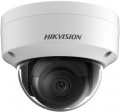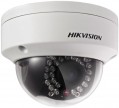Smart features
Functions that automate the process of video monitoring, analysis and response to events, which helps to minimize the human factor and increase the efficiency of video surveillance systems.
—
Perimeter protection. This option is used when deploying complex video surveillance systems with a recorder and cameras, combining the expanded functionality of intelligent video analytics capabilities for monitoring boundaries. Perimeter protection can cover various functions, for example, tracking the intersection of virtual lines, the appearance or disappearance of objects in the frame, setting up protected zones, if the boundaries of which are violated, an alarm will be activated, and so on. The full list of features should be specified separately. It is important to note that for the listed functions, analysis of objects in the frame can be used - detection of people, classification of vehicles, etc.
—
Definition of a person. Cameras with this function can detect the presence of people in the frame by the characteristic outlines of their silhouettes. Once a person's presence is detected, an alarm can be activated, and moving PTZ cameras can follow people in the frame.
—
Definition of a car. The ability of a video surveillance camera to automatically recognize and highlight objects in the frame that are vehicles. This can be useful for monitoring t
...raffic, controlling parking, or ensuring the safety of roads within a controlled perimeter. A more advanced implementation of this function is license plate recognition (see below).
— Definition of animal. The function of identifying various “living creatures” in the frame: pets, neighbor’s cats and dogs, alien wild animals, etc. Video surveillance systems with this functionality can be used to minimize false alarms, monitor pets to make sure they are safe and in order, and to solve other similar problems.
— License plate recognition. Special tools that provide additional capabilities for reading license plates. The specific capabilities of such tools may be different in different models; they should be clarified separately. So, some cameras only read letters and numbers and transmit the information to the recorder for further processing. Others have built-in databases, so they can compare the read number with the base and provide various actions depending on the result - for example, send a signal to open the barrier if the number is “allowed”. However, in any case, cameras with this feature are well suited for objects where it is necessary to control the movement of cars - for example, parking lots (including closed service ones).
— Facial recognition. Cameras with this function are able to at least recognize the presence of faces in the frame; but the further use of this data and the special functionality of such cameras may be different. Thus, relatively simple models react only to the very fact of detecting a face, but even this provides quite extensive additional capabilities: focusing on a face, tracking a person in the frame (in moving PTZ cameras), etc. And more advanced cameras can recognize characteristic features faces by which a specific person can be identified. This functionality, among other things, allows the surveillance system to compare the faces “seen” by the camera with the stored database and take various actions based on this - for example, allow or deny access, warn about an unwanted visitor or unauthorized use of a key card, etc. P.
Note that face recognition tools can also be found in recorders to which cameras are connected. However, the presence of such functions in the cameras themselves can also be useful - especially if the existing recorder “does not shine with capabilities” in this regard, or the system does not have a recorder at all (for example, it consists of IP cameras connected via a router to a PC).
— People counting. A function that allows the camera to count the number of people in the frame; the received data is stored in its own memory and can be sent to a recorder or other external device. Note that in most models this feature is combined with the face recognition described above, thanks to which the camera is able not only to count all people in a row, but to recognize tech who are in the frame again. However, people counting can be used for both statistical and security purposes. For example, at large facilities such as office and shopping centers, it allows you to determine whether all visitors who entered the premises left it before the end of working hours.Video resolution
The maximum video resolution that the camera can capture.
The higher the resolution of the video, the more details you can see on it, the less details will be blurry. On the other hand, high resolution means large volumes of video materials, which, accordingly, requires capacious media for their storage and fast communication channels for broadcasting video in real time. Yes, and this indicator significantly affects the cost of the camera.
Frame rate
The maximum frame rate in the video captured by the camera.
The higher the frame rate, the clearer the image, the less noticeable blurring when moving in the frame (especially fast). On the other hand, this indicator affects the amount of information recorded during shooting, as well as the cost of the camera itself. Therefore, it makes sense to specifically look for
a video surveillance camera with high-speed shooting(45 fps and higher) only if a clear recording of fast moving objects is important to you.
Signal to noise ratio
The signal-to-noise ratio that the surveillance camera corresponds to.
This indicator describes the ratio of the level of the useful signal (the actual image produced by the camera to an external device) to the level of extraneous noise that inevitably arises during the operation of electronic circuits. Such noise appears in the image as characteristic noise (“snow”). The higher the signal-to-noise ratio, the less interference on the screen, the clearer and better the image is, and the smaller the volume of recorded video files. It is believed that visible noise practically disappears at a ratio of at least 45 dB. However, among modern cameras there are also higher rates.
Backlight compensation
—
WDR (Wide Dynamic Range) — extended dynamic range. WDR technology combines several frames with different exposures into one picture, as a result, dark areas are brightened, and overexposures are darkened, and the output is a picture with extremely uniform lighting. The true wide dynamic range technology is called True-WDR and it is implemented in the optical circuit at the hardware level, a special microprocessor is responsible for creating and mixing exposures. A more affordable alternative to wide dynamic range is Digital-WDR technology, which equalizes lighting through software algorithms.
—
DWDR (Digital Wide Dynamic Range) — extended dynamic range technology based on software brightening algorithms. DWDR brightens too dark areas of the frame, which can be completely blurred against the background of light areas. Digital brightening allows you to noticeably improve the quality of shooting in contrasting lighting conditions. Digital WDR cameras are noticeably cheaper than true True-WDR optics. Of course, the quality of digital brightening is inferior to True-WDR.
—
BLC (Back Light Compensation) — backlight compensation technology. This system is based on the work of digital signal processors DSP. So, the device, relatively speaking, "breaks" the frame into many segments, making its own adjustments to each of them. Backlight compensation brightens dark areas of
...the frame well. The main disadvantage of the technology is the increase in the brightness of the already bright areas of the frame, due to which overexposure may appear in the picture.
— WDR+BLC. The camcorder supports several lightening technologies at once, each of which is described in more detail above. Immediately, we note that the combination of WDR + BLC allows you to achieve an extremely clear and clear picture in almost any lighting conditions, from extreme contrast to insufficient and excessively bright.
— DWDR+BLC. The device supports two popular clarification technologies at once, each of which is described in more detail above. The presence of DWDR + BLC technologies allows the camera to effectively brighten the dark areas of the frame. Such video cameras have proven themselves well when working in low light conditions.Horizontal viewing angle
Horizontal viewing angle of the surveillance camera. For models with a variable value, the maximum value is indicated, since it is the width of the image that is important, and when zooming in, the zoom factor is more important than the angle. This paragraph also indicates the general angle of view for models with a circular field of view – in particular, cameras with a fisheye lens (see above)
The wider the viewing angle, the more space the camera captures and at the same time, the smaller the images of individual objects in the frame are obtained. Therefore, when choosing by this parameter, it is worth deciding what is more important – the ability to view a large scene or the visibility of small details in a relatively narrow field of view. Also note that with a wide field of view (100° or more), characteristic distortions can be observed at the edges of the frame, and the wider the angle, the more pronounced they are. This phenomenon can be eliminated by panoramic shooting (see "Design and features"), but this feature, in turn, complicates and increases the cost of the camera.
Vertical viewing angle
Vertical viewing angle of the surveillance camera. In models with a variable value, the maximum is indicated, and the angle when zooming is not so important.
The wider the viewing angle, the more space the camera captures and at the same time, the smaller the images of individual objects in the frame are obtained. Therefore, when choosing by this parameter, it is worth deciding what is more important – the ability to view a large scene or the visibility of small details in a relatively narrow field of view.
Video compression format
The video compression format used by the camera.
Compression is used to reduce the file sizes of captured video; different technologies can be used for this — the so-called codecs, their list is given in this paragraph. From a practical point of view, compatibility with external recording and playback devices primarily depends on the supported codecs. If you plan to use a computer as a recorder / player, you can ignore this list: modern PCs and laptops usually support a very extensive list of formats, and in extreme cases, the missing codecs can be installed separately. But if we are talking about specialized registrars, individual players (like home media centers), etc. — codec compatibility should be clarified further. So, if the advanced modern
H.265 standard is very widely supported nowadays, then the more specific
H.265+, originally created for surveillance systems, is much less common even in specialized equipment.
Power consumption
The power consumed by CCTV cameras during operation. Knowing the indicator of energy consumption, you can, for example, calculate the battery life of equipment from an uninterruptible power supply or choose a suitable “uninterruptible power supply”. Also, with the support of PoE technology, it is worth considering the power consumption when choosing a PoE switch or PoE adapter.

